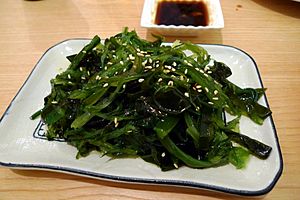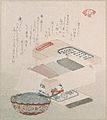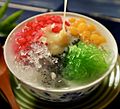Edible seaweed facts for kids
Edible seaweed (also called sea vegetables) are types of seaweed that people can eat. They are used in cooking all over the world. They are often rich in fiber. These sea plants belong to different groups of algae, like red algae, green algae, and brown algae.
Seaweeds are also collected or grown to get special substances called polysaccharides. Examples include alginate, agar, and carrageenan. These are gel-like materials known as hydrocolloids. Hydrocolloids are very important in business, especially for making food. They are used as food additives because they can make things gel, hold water, or mix ingredients well.
Most edible seaweeds grow in the ocean. Most freshwater algae are not safe to eat. Some ocean algae can upset your stomach, while others can help with digestion. Most large ocean algae are safe to eat in normal amounts. However, some types, like Lyngbya majuscula, can cause skin irritation if you touch them. Also, some Desmarestia species are very acidic and can cause serious stomach problems if eaten.
The dish sometimes called 'Crispy Seaweed' in Western Chinese restaurants is usually not seaweed at all! It's often cabbage that has been dried and then fried.
Contents
Where Seaweed is Found and Eaten
Seaweeds are a big part of coastal cooking around the world. People have eaten seaweed in China, Japan, and Korea for thousands of years.
Seaweed is also eaten in many traditional European places. This includes Iceland, western Norway, the Atlantic coast of France, and parts of Ireland, Wales, and South West England. It's also popular in parts of eastern Canada like New Brunswick, Nova Scotia, and Newfoundland and Labrador. The Māori people of New Zealand and Indigenous Australians also traditionally ate several kinds of seaweed.
Nutrition and How Seaweed is Used

Seaweeds are a great source of important nutrients. These include proteins, vitamins, minerals, and fiber. They also have special molecules like polyphenols and polysaccharides that are good for your health. Compared to plants grown on land, seaweeds have more healthy fats like EPA and DHA.
Seaweed is also rich in iodine and tyrosine. These are important for your body. Some people think seaweed can be a source of Vitamin B12 for vegans. This vitamin comes from tiny bacteria living on the seaweed. However, many nutrition experts say that seaweed is not a reliable source of B12.
Seaweed is used in many different foods:
- As nori to wrap sushi and onigiri.
- In soups, stews, and hot pots.
- In salads.
- As crispy seaweed snacks.
- In instant noodles.
- As food for farm animals.
Seaweeds have many polysaccharides that can act as prebiotics. Prebiotics are special fibers that help good bacteria grow in your gut. These good bacteria can improve your health. Seaweed also contains other natural compounds like terpenoids. This means algae are a natural source of many healthy ingredients. They can be used to make functional foods, which are foods that offer extra health benefits. Some people, especially in Japan, have special gut enzymes that help them digest seaweed polysaccharides. This is because they eat a lot of seaweed.
Chondrus crispus (also called Irish moss) is a red algae used to make food additives. Other seaweeds like Kappaphycus are also used for this.
Some edible seaweeds are thought to have health benefits. They might help with inflammation, allergies, and even protect against certain diseases. Red seaweeds like Dulse (Palmaria palmata) and Nori (Porphyra tenera) are good sources of protein, minerals, and fiber.
Interestingly, feeding the seaweed Asparagopsis taxiformis to cows can reduce the amount of methane gas they release. Methane is a greenhouse gas that contributes to climate change.
Seaweed in East Asia
In parts of Asia, dried sheets of the red algae Porphyra are very popular. They are called nori 海苔 in Japan, zicai 紫菜 in China, and gim 김 in Korea. These sheets are used in soups or to wrap sushi and onigiri.
Japanese cuisine has specific names for seven types of seaweed used in food. The general term for seaweed in Japanese is mostly used in science, not for food.
Agar-agar (called kanten 寒天 in Japan) was likely first found in Japan. It is widely used as a substitute for gelatin in desserts.
-
Dasima (kelp)
-
Sea grapes, a tropical edible seaweed, are also eaten in Japan. They are either imported or grown in Okinawa.
Seaweed in Southeast Asia
Sea grapes (Caulerpa lentilifera and Caulerpa racemosa) and Gusô (Eucheuma spp.) are traditionally eaten in Southeast Asian countries. They are also popular in Oceania and warmer parts of East Asia. These warm-water seaweeds were first grown commercially in the Philippines. In the northern Philippines, a cold-water red seaweed called Pyropia vietnamensis is gathered and dried into black sheets called gamet. These are used in cooking, similar to nori.
In the Philippines, a traditional ingredient is gulaman. This is made from carrageenan, which is taken from edible seaweed. The Philippines was a pioneer in growing seaweed for this purpose. Gulaman is used as a substitute for gelatin and is popular in many traditional desserts. Using carrageenan as a gelatin substitute has also spread to other parts of Southeast Asia, like Indonesia, where it's used in desserts like es campur.
People in Tiwi, Albay, also process seaweed into noodles. These noodles can be used to make dishes like pancit canton, pancit luglug, spaghetti, or carbonara. Seaweed noodles are rich in calcium, magnesium, and iodine.
-
Sea grapes (Caulerpa lentilifera) were first grown in the Philippines. They are often eaten raw with vinegar, as a snack or in a salad.
-
Gusô (Eucheuma spp.) is another edible tropical seaweed from the Philippines. It's eaten fresh, like sea grapes, or processed into carrageenan.
-
Buko pandan, a dessert drink from the Philippines. It uses pandan-flavored cubes of gulaman, a gelatin-substitute made from carrageenan.
Common Edible Seaweeds
Here are some common types of edible seaweeds:
Red Algae (Rhodophyta)
Green Algae
|
Brown Algae (Phaeophyceae)Kelp (Laminariales)
Fucales
Ectocarpales
|
See also
 In Spanish: Alga comestible para niños
In Spanish: Alga comestible para niños












